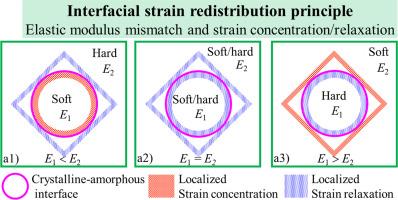Interfacial strain concentration and relaxation along crystalline-amorphous boundaries of B2-reinforced bulk-metallic-glass-composites during loading
IF 8.3
1区 材料科学
Q1 MATERIALS SCIENCE, MULTIDISCIPLINARY
引用次数: 0
Abstract
Interfacial stress concentration promotes both martensitic transformation nucleation and shear band initiation in B2-reinforced bulk-metallic-glass-composites. As the martensitic transformation occurs in the crystalline (soft) regime, shear bands are often observed in the amorphous (hard) matrix. A long-standing question has been when the stress concentration will prompt the martensitic transformation and when it will give rise to shear band initiation. By definition, stress concentration results from the regional Young's modulus multiplied by the local strain concentration. The localized strain concentration along crystalline-amorphous boundary plays decisive roles in promoting phase transformation and localized shear events. By constantly tracking the interfacial strain distribution through Molecular Dynamics methods, the location and magnitude of the interfacial strain concentration and its relaxation are quantified and correlated with the regional modulus differences. We are proposing that the regional strain concentration and relaxation is always located along soft/hard domains during loading so as to maintain the compatibility of interfacial deformation.


求助全文
约1分钟内获得全文
求助全文
来源期刊

Acta Materialia
工程技术-材料科学:综合
CiteScore
16.10
自引率
8.50%
发文量
801
审稿时长
53 days
期刊介绍:
Acta Materialia serves as a platform for publishing full-length, original papers and commissioned overviews that contribute to a profound understanding of the correlation between the processing, structure, and properties of inorganic materials. The journal seeks papers with high impact potential or those that significantly propel the field forward. The scope includes the atomic and molecular arrangements, chemical and electronic structures, and microstructure of materials, focusing on their mechanical or functional behavior across all length scales, including nanostructures.
 求助内容:
求助内容: 应助结果提醒方式:
应助结果提醒方式:


